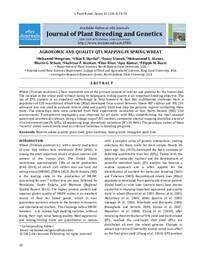AGRONOMIC AND QUALITY QTL MAPPING IN SPRING WHEAT

Authors:
Wheat (Triticum aestivum L.) flour represents one of the primary sources of calories and proteins for the human diet.
The increase in the wheat yield without losing its baking and milling quality is an important breeding objective. The
use of QTL analysis is an expedient methodology to help breeders to face this multifaceted challenge. Here, a
population of 129 recombinant inbred lines (RILs) developed from a cross between ‘Steele-ND’ cultivar and ‘ND 735’
advanced line was used to evaluate several yield and quality traits and map the genomic regions controlling these
traits. The phenotypic data were collected from field experiments conducted at four North Dakota (ND), USA
environments. Transgressive segregation was observed for all traits, with RILs outperforming the most adapted
parent and commercial cultivars. Using a linkage map of 392 markers, composite interval mapping identified a total of
13 environment-specific QTLs, all explaining large phenotypic variations (R2=16-44%). The genotypic values of these
“reserve” alleles were directly used as criteria of selection in breeding programs.
